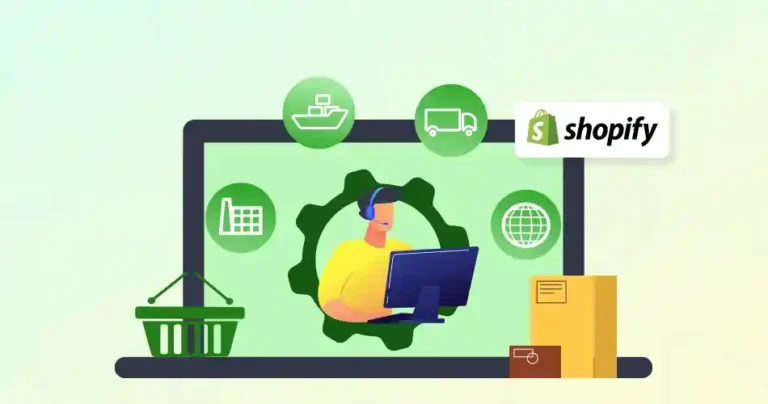eCommerce businesses face a constant challenge of optimizing their operations, especially when managing high transaction volumes. A single missed notification can lead to delayed orders, frustrated customers, and ultimately, lost revenue.
But tracking codes like Shopify-EP can help optimize the shipping process for online store owners. It serves as a delivery service integrated into Shopify’s platform, so businesses can manage orders efficiently.
Through this blog, we’ll explain how the Shopify experts set up EP packages and ensure the best results. Let’s begin.
What is ‘Shopify-EP’?
“Shopify-EP” refers to a specific tracking notification related to packages shipped from stores using the Shopify eCommerce platform. The “EP” stands for “Enhanced Processing,” indicating that the package is being handled through Shopify’s specialized logistics network.
This network often involves third-party carriers and fulfillment centers working in conjunction to streamline deliveries. Essentially, if you see “Shopify-EP” in a tracking update (often from USPS or other carriers), it means the package you’re tracking originated from a Shopify-powered online store. It is being processed through Shopify’s enhanced shipping system.
How to Set Up Shopify-EP?
Shopify-EP isn’t something you directly configure in your Shopify settings. Instead, it’s a result of how you set up your shipping and fulfillment within Shopify. Here’s a breakdown of how it works:
Enable Shopify Shipping
This is the foundation. By enabling Shopify Shipping in your admin settings (Settings > Shipping and Delivery), you unlock access to discounted rates and integrations with major carriers like USPS, UPS, and DHL.
Define Shipping Zones
Clearly define where you ship your products (domestic, international, specific regions). This ensures accurate shipping rates and efficient routing, which is crucial for Shopify-EP to function smoothly.
Set Up Carrier Integration
Connect your Shopify store with the carriers you want to use. This allows for real-time rate calculations, label printing, and automated tracking updates, all of which contribute to the “Enhanced Processing” of Shopify-EP.
Choose Fulfillment Options
There are several options for eCommerce fulfillment with your Shopify store. One’s Shopify Fulfillment Network (SFN) and other’s Third-party Fulfillment.
- Shopify Fulfillment Network (SFN): If you opt to use Shopify’s own fulfillment network, your products will be stored and shipped from their warehouses, which heavily utilizes the “Enhanced Processing” system.
- Third-Party Fulfillment: If you use a third-party logistics (3PL) provider that integrates with Shopify, this can also trigger Shopify-EP tracking. Shopify’s system coordinates with the 3PL for tracking updates.
- Self-Fulfillment: Even if you ship orders yourself, using Shopify Shipping and its carrier integrations can still result in Shopify-EP tracking, as it leverages Shopify’s shipping infrastructure.
In essence, Shopify-EP is an automatic outcome of using Shopify’s shipping features and infrastructure. You don’t “set it up” separately; it’s the system working in the background to streamline your shipping process.
To implement this process the best way, you can consult with our professional Shopify development company.
Common Concerns with Shopify-EP
If you’re confused about receiving a ‘Shopify-EP’ tracking number or if you didn’t expect a package, here are some helpful steps to take:
- Check with Family or Friends: Ask people around you—like family members, roommates, or friends—if they’ve ordered something from a Shopify store or if they might have sent you a gift. Sometimes packages are surprises, and the recipient is unaware of the order details.
- Contact Shopify Support: If you cannot identify the source of the package, reach out to Shopify’s customer support team. Provide the tracking number and any relevant information. Shopify support may be able to assist by identifying the store that shipped your package.
- Verify the Sender: If you know someone who may have used Shopify to send you a package, you can directly contact them to confirm. This could help you clarify whether the package is indeed meant for you.
- Exercise Caution: If you’re still unsure about the origin of the package, exercise caution. It’s best not to open the package until you have more clarity. If the delivery seems unsolicited or suspicious, consider contacting the postal service.
- Report to Local Authorities: In cases where you suspect that the package may be fraudulent or suspicious, it’s important to contact local authorities or the postal service to report it. They can investigate and take appropriate action.
Overall, while “Shopify-EP” generally indicates an efficient shipping process, there are some potential concerns that need to be addressed through tracking and communication.
Shopify Features to Integrate with EP
The ‘Shopify-EP’ logistics service is part of a broader ecosystem of tools that Shopify provides to online merchants. Shopify itself is an incredibly powerful platform designed to help businesses create and manage online stores.
The logistics service plays a crucial role in streamlining order fulfillment, and it comes with a range of additional features to enhance the e-commerce experience.
Here are some of the notable features that integrate with Shopify-EP:
- Advanced Analytics and Reporting: Shopify’s analytics and reporting tools provide insights into your store’s performance. Sellers can track web traffic, sales, customer behavior, and more, helping them make data-driven decisions.
- Seamless Integration with Third-Party Apps: Shopify allows users to integrate their store with a variety of third-party applications. From payment processors to shipping services, these integrations ensure smooth operations and a seamless experience for both sellers and buyers.
- Customization Options: Shopify offers a range of customization options to help store owners enhance their websites. Whether it’s theme customization, mobile responsiveness, or page speed optimization, Shopify helps sellers create an engaging, high-performing store.
- Enhanced SEO Tools and Marketing Analytics: Shopify helps store owners optimize their websites for search engines, conduct keyword research, and analyze their marketing efforts. These tools ensure that businesses can reach a wider audience and increase their visibility online.
- Comprehensive Product and Inventory Management: Shopify’s inventory management tools help sellers list and manage products efficiently. Sellers can track inventory, categorize products, and even integrate with third-party applications to boost their customer experience.
With a feature-rich Shopify-EP implementation, you can ensure a more efficient shipping, accurate tracking, and ultimately, happier customers.
For that, you can consult with our skilled Shopify developers. We will ensure your EP implementation delivers the best results.
When Would You Receive a ‘Shopify-EP’ Tracking Number?
If you’ve received a ‘Shopify-EP tracking number’, you may be wondering why. There are several reasons why this tracking label might be assigned to your order:
- Recent Purchase: If you’ve recently bought an item from a Shopify-powered store, the tracking number you receive could be labeled ‘Shopify-EP.’ This is because the seller is using Shopify’s logistics service to process and ship your order.
- Gift or Surprise Package: Sometimes, someone might send you a gift or surprise package from a Shopify store, and the tracking number associated with that delivery might be marked as ‘Shopify-EP’.
- Incorrect or Mistaken Notification: It’s possible that you received a mistaken tracking number. Occasionally, tracking labels might be issued for packages intended for someone else, or there might be an error in the system.
In any case, receiving a ‘Shopify-EP’ tracking number typically means that your package is linked to a Shopify-powered store, but if you’re unsure, there are steps you can take to clarify.
Shopify-EP Wrap-Up
“Shopify-EP” signifies a package being processed through Shopify’s enhanced shipping infrastructure, often involving integrated carriers and fulfillment networks. It’s not a feature to be directly set up but rather an outcome of utilizing Shopify’s shipping functionalities.
Key elements contributing to Shopify-EP include Shopify Shipping, carrier integrations, the Shopify Fulfillment Network (SFN), third-party fulfillment connections, and optimized shipping profiles. While generally indicating efficient processing, potential concerns include customer unfamiliarity with the term, limited tracking details, and occasional delays.If you need help with implementing Shopify-EP, let’s connect today!
FAQs on Shopify EP
Q1. What is Shopify-EP?
Shopify-EP is Shopify’s logistics solution that optimizes shipping by working with third-party carriers and fulfillment centers. It ensures efficient order tracking and delivery for online stores.
Q2. Can I migrate my existing Shopify store to Shopify-EP?
Shopify provides tools and support to help merchants migrate from a standard Shopify plan to Shopify Plus seamlessly.
Q3. What is Launchpad, and how does it help?
Launchpad is a tool exclusive to Shopify-EP users that allows businesses to plan and automate flash sales, product launches, and marketing campaigns, ensuring smooth operations during high-traffic events.
Q4. Can I customize the checkout process with Shopify-EP?
Yes, Shopify EP allows you to customize the checkout process using the Shopify Plus Checkout SDK for a tailored customer experience.





